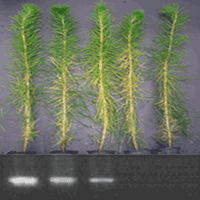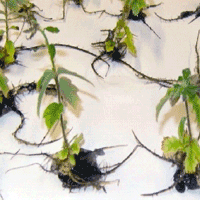Tolerance to metal stress was studied in seedlings of three pine species (Pinus radiata, P. pinaster and P. canariensis) under controlled ex vitro conditions. Mature female cones were randomly collected at two sites in Chile (Llico and Huilquilemu) characterized by contrasting environmental conditions. One-year-old pine seedlings were immersed in trays with solutions of CuSO4 (300 mM) or AlCl3 (100 mM), and their survival, growth rate and decay symptoms were recorded for 60 days. Results showed large differences among provenances in seedling tolerance to CuSO4 and AlCl3 in terms of survival and growth. Multivariate analysis revealed a significant association (p <0.0001) between the first canonical function and the following variables: provenance, species, metal stress and growing rate, as well as between the second canonical function and provenance, species, metal stress and symptomatology, indicating a high degree of genotype-environment interaction. Moreover, the activity of POX, SOD and CAT enzymes was determined 60 days after the beginning of the experiment in the Llico provenance seedlings. P. pinaster showed the highest activity level for all the enzymes considered, while P. canariensis and P. radiata had intermediate and lowest values, respectively. Differential gene expression among pine seedlings under metal stress with CuSO4 for two genes (Cu-Zn-superoxide dismutase and RuBisCo) confirmed P. pinaster as the most tolerant species to CuSO4 treatment. Our results are consistent with the hypothesis that abiotic stress in the maternal environment can induce a “transgenerational plasticity” which could affect progeny performances. The influence of different genetic backgrounds on the tolerance to heavy metals in pine seedlings is also discussed.
Keywords
, , ,
Citation
Arencibia AD, Rodríguez C, Roco L, Vergara C, González-Soto N, García-González R (2016). Tolerance to heavy metal stress in seedlings of three pine species from contrasting environmental conditions in Chile. iForest 9: 937-945. - doi: 10.3832/ifor1908-009
Academic Editor
Claudia Cocozza
Paper history
Received: Nov 02, 2015
Accepted: May 02, 2016
First online: Aug 12, 2016
Publication Date: Dec 14, 2016
Publication Time: 3.40 months
© SISEF - The Italian Society of Silviculture and Forest Ecology 2016
Open Access
This article is distributed under the terms of the Creative Commons Attribution-Non Commercial 4.0 International (https://creativecommons.org/licenses/by-nc/4.0/), which permits unrestricted use, distribution, and reproduction in any medium, provided you give appropriate credit to the original author(s) and the source, provide a link to the Creative Commons license, and indicate if changes were made.

Breakdown by View Type
(Waiting for server response...)
Article Usage
Total Article Views: 49937
(from publication date up to now)
Breakdown by View Type
HTML Page Views: 42941
Abstract Page Views: 2597
PDF Downloads: 3248
Citation/Reference Downloads: 46
XML Downloads: 1105
Web Metrics
Days since publication: 3409
Overall contacts: 49937
Avg. contacts per week: 102.54
Article Citations
Article citations are based on data periodically collected from the Clarivate Web of Science web site
(last update: Mar 2025)
Total number of cites (since 2016): 4
Average cites per year: 0.40
Publication Metrics
by Dimensions ©
Articles citing this article
List of the papers citing this article based on CrossRef Cited-by.
(1)
Acquaviva R, Vanella L, Sorrenti V, Santangelo R, Iauk L, Russo A, Savoca F, Barbagallo I, Di Giacomo C (2012)Biochemical modifications in
Pinus pinaster Ait. as a result of environmental pollution. Environmental Science Pollution Research 19: 3850-3858.
CrossRef |
Gscholar
(2)
Alscher RG, Erturk N, Heath LS (2002)Role of superoxide dismutases (SODs) in controlling oxidative stress in plants. Journal of Experimental Botany 53: 1331-1341.
CrossRef |
Gscholar
(3)
Andreotti C, Ravaglia D, Ragaini A, Costa G (2008)Phenolic compounds in peach (
Prunus persica) cultivars at harvest and during fruit maturation. Annals of Applied Biology 153: 11-23.
CrossRef |
Gscholar
(4)
Apel K, Hirt H (2004)Reactive oxygen species: metabolism, oxidative stress, and signal transduction. Annual Review of Plant Biology 55: 373-399.
CrossRef |
Gscholar
(5)
Au DWT (2012)New directions in ecotoxicology and meeting the challenges ahead. Environmental Science and Pollution Research 19 (7): 2463-2464.
CrossRef |
Gscholar
(6)
Baize D (2009)Cadmium in soils and cereal grains after sewage-sludge application on French soils. A review. Agronomy for Sustainable Development 29: 175-184.
CrossRef |
Gscholar
(7)
Bania I, Mahanta R (2012)Evaluations of peroxidase from various plant sources. International Journal of Scientific and Research Publications 2: 1-5.
Gscholar
(8)
Beers RF, Sizer IW (1952)A spectrophotometric method for measuring the breakdown of hydrogen peroxide by catalase. Journal of Biological Chemistry 195: 133-140.
Gscholar
(9)
Bithell SL, Butler RC, Harrow S, McKay A, Cromey MG (2011)Susceptibility to take-all of cereal and grass species, and their effects on pathogen inoculum. Annals of Applied Biology 159: 252-266.
CrossRef |
Gscholar
(10)
Boscolo PRS, Menossib M, Jorgea RA (2003)Aluminum induced oxidative stress in maize. Phytochemisty 62: 181-189.
CrossRef |
Gscholar
(11)
Boyko A, Kovalchuk I (2011)Genome instability and epigenetic modification-heritable responses to environmental stress? Current Opinion in Plant Biology 14: 260-266.
CrossRef |
Gscholar
(12)
Bray E, Bailey-Serres J, Weretilnyk E (2000)Responses to abiotic stresses. In: “Biochemistry and molecular biology of plants” (Buchanan B, Gruissem W, Jones R eds). American Society of Plant Physiologists, Rockville, MD, USA, pp. 1158-1203.
Gscholar
(13)
Cankaya S, Balkaya A, Karaagac O (2010)Canonical correlation analysis for the determination of relationships between plant characters and yield components in red pepper [C
apsicum annuum L. var.
conoides (Mill.) Irish]. Spanish Journal of Agricultural Research 8: 67-73.
CrossRef |
Gscholar
(14)
Chudzinska E, Diatta JB, Wojnicka-Póltorak A (2014)Adaptation strategies and referencing trial of Scots and blackpine populations subjected to heavy metal pollution. Environmental Science Pollution Research 21: 2165-2177.
CrossRef |
Gscholar
(15)
Cobbett C, Goldbrough PB (2002)Phytochelatins and metallathioneins: roles in heavy metal detoxification and homeostasis. Annual Review of Plant Biology 53: 159-182.
CrossRef |
Gscholar
(16)
Coleman TW, Clarke SR, Meeker J, Rieske LK (2008)Forest composition following overstory mortality from southern pine beetle and associated treatments. Canadian Journal of Forest Research 38: 1406-1418.
CrossRef |
Gscholar
(17)
Donohue K (2002)Germination timing influences natural selection on life-history characters in
Arabidopsis thaliana. Ecology 83: 1006-1016.
CrossRef |
Gscholar
(18)
Elstner EF (1991)Mechanisms of oxygen activation in different compartments of plant cells. In: “Active oxygen/oxidative stress and plant metabolism” (Pell EJ, Steffen KL, eds). American Society of Plant Physiologists, Rockville, MD, USA, pp. 13-25.
Gscholar
(19)
Elwell AL, Gronwall DS, Miller ND, Spalding EP, Durhambtl DS (2011)Separating parental environment from seed size effects on next generation growth and development in Arabidopsis. Plant, Cell and Environment 34: 291-301.
CrossRef |
Gscholar
(20)
Faucon M, Chipeng F, Verbruggen N, Mahy G, Colinet G, Shutcha M, Pourret O, Meerts P (2012)Copper tolerance and accumulation in two cuprophytes of South Central Africa:
Crepidorhopalon perennis and
C. tenuis (Linderniaceae). Environmental and Experimental Botany 84: 11-16.
CrossRef |
Gscholar
(21)
Foyer CH, Noctor G (2005)Redox homeostasis and antioxidant signaling: a metabolic interface between stress perception and physiological responses. The Plant Cell 17: 1866-1875.
CrossRef |
Gscholar
(22)
Galloway LF (2005)Maternal effects provide phenotypic adaptation to local environmental conditions. New Phytologist 166: 93-100.
CrossRef |
Gscholar
(23)
Galloway LF, Etterson JR (2007)Transgenerational plasticity is adaptive in the wild. Science 318: 1134-1136.
CrossRef |
Gscholar
(24)
Giannakoulas A, Moustakas M, Syros T, Yupsanis T (2010)Aluminum stress induces up-regulation of an efficient antioxidant system in the Al-tolerant maize line but not in an Al sensitive line. Environmental and Experimental Botany 67: 487-494.
CrossRef |
Gscholar
(25)
Hall JL (2002)Cellular mechanisms for heavy metal detoxification and tolerance. Journal of Experimental Botany 53: 1-11.
CrossRef |
Gscholar
(26)
Herman JJ, Sultan SE (2011)Adaptive trans-generational plasticity in plants: case studies, mechanisms, and implications for natural populations. Frontiers in Plant Sciences 2: 1-10.
Gscholar
(27)
Kumar M, Yadav V, Tuteja N, Tohri AK (2009)Antioxidant enzyme activities in maize plants colonized with
Piriformospora indica. Microbiology 155: 780-790.
CrossRef |
Gscholar
(28)
Matsumoto H (2000)Cell biology of aluminum toxicity and tolerance in higher plants. International Review of Cytology 200: 1-46.
CrossRef |
Gscholar
(29)
MacFarlane GR, Burchett MD (2001)Photosynthetic pigments and peroxidase activity indicators of heavy metal stress in the Grey Mangrove,
Avicennia marina (Forsk.) Vierh. Marine Pollution Bulletin 42: 233-240.
CrossRef |
Gscholar
(30)
Mazen A, Faheed FA, Ahmed AF (2010)Study of potential impacts of using sewage sludge in the amendment of desert reclaimed soil on wheat and jews mallow plants. Brazilian Archive of Biology and Technology 53: 917-930.
CrossRef |
Gscholar
(31)
Mittler R, Vanderauwera S, Gollery M, Van Breusegem F (2004)The reactive oxygen gene network in plants. Trends in Plant Sciences 9: 490-498.
CrossRef |
Gscholar
(32)
Parra S, Bravo MA, Quiroz W, Moreno T, Karanasiou A, Font O, Vidal V, Cereceda F (2014)Distribution of trace elements in particle size fractions from contaminated soils by a copper smelting from different zones of the Puchuncavi Valley (Chile). Chemosphere 111: 513-521.
CrossRef |
Gscholar
(33)
Prus-Glowacki W, Urbaniak L, Bujas E, Curthus AL (2012)Genetic variation of isolated and peripheral populations of
Pinus sylvestris (L.) from glacial refugia. Flora - Morphology, Distribution, Functional Ecology of Plants 207: 150-158.
CrossRef |
Gscholar
(34)
Roth EF, Gilbert HS (1984)Pyrogallol assay for SOD: absence of a glutathione artifact. Analytical Biochemistry 137: 50-53.
CrossRef |
Gscholar
(35)
Schützendübel A, Polle A (2002)Plant responses to abiotic stresses: heavy metal induced oxidative stress and protection by mycorrhization. Journal of Experimental Botany 53: 1351-1365.
CrossRef |
Gscholar
(36)
Sharma P, Dubey RS (2007)Involvement of oxidative stress and role of antioxidative defense system in growing rice seedlings exposed to toxic concentrations of aluminum. Plant Cell Reports 11: 2027-2038.
CrossRef |
Gscholar
(37)
Simonovičová M, Huttová J, Mistrík I, Siroká B, Tamás L (2004)Root growth inhibition by aluminum in probably caused by cell death due to peroxidase-mediated hydrogen peroxide production. Protoplasma 224: 91-98.
Gscholar
(38)
Ter Braak CJF (1986)Canonical correspondence analysis: a new eigenvector technique for multivariate direct gradient analysis. Ecology 67: 1167-1179.
CrossRef |
Gscholar
(39)
Velasco-Conde T, Yakovlev I, Majada JP, Aranda I, Johnsen O (2012)Dehydrins in maritime pine (
Pinus pinaster) and their expression related to drought stress response. Tree Genetics and Genomes 8: 957-973.
CrossRef |
Gscholar
(40)
Violle C, Jiang L (2009)Towards a trait-based quantification of species niche. Journal of Plant Ecology 2: 87-93.
CrossRef |
Gscholar
(41)
Wannaz ED, Carreras HA, Pérez CA, Pignata ML (2006)Assessment of heavy metal accumulation in two species of
Tillandsia in relation to atmospheric emission sources in Argentina. Science of the Total Environment 361: 267-278.
CrossRef |
Gscholar
(42)
Yadav SK, Mohanpuria P (2009)Responses of
Camellia sinensis cultivars to Cu and Al stress. Biologia Plantarum 53: 737-740.
CrossRef |
Gscholar
(43)
Yang L, Zambrano Y, Hu CJ, Carmona ER, Bernal A, Pérez A, Zayas CM, Li YR, Guerra A, Santana I, Arencibia AD (2010)Sugarcane metabolites produced in CO
2-rich temporary immersion bioreactors (TIBs) induce tomato (
Solanum lycopersicum) resistance against bacterial wilt (
Ralstonia solanacearum). In Vitro Cellular and Developmental Biology - Plant 46 (6): 558-568.
CrossRef |
Gscholar
(44)
Yamamoto Y, Kobayashi Y, Devi SR, Rikiishi S, Matsumoto H (2003)Oxidative stress triggered by aluminum in plant roots. Plant and Soil 255 (1): 239-243.
CrossRef |
Gscholar


















